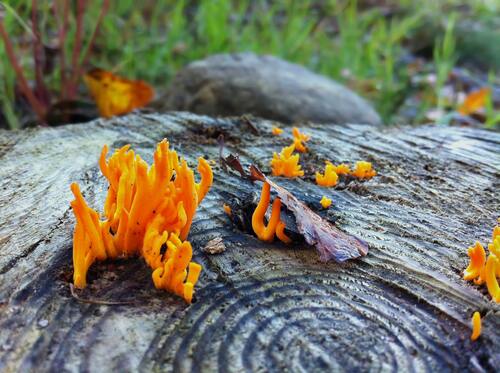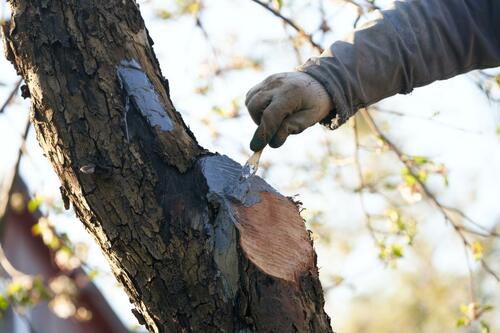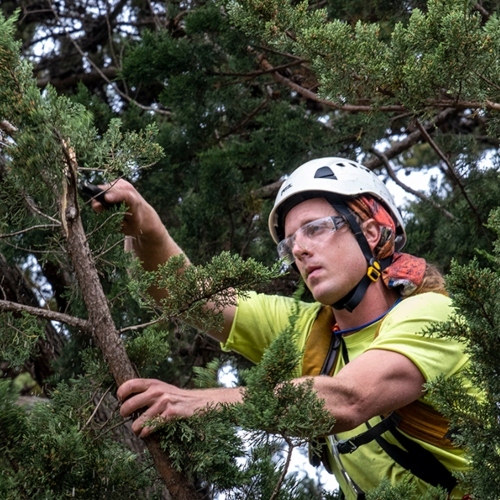Wound Paint: Falling Out of Favor
Introduction
In the past, arborists and tree care professionals commonly applied latex- or petroleum-based paint to freshly pruned branches, aiming to prevent decay and ultimately save the tree from potential death. However, this practice has significantly decreased in popularity, and it’s now rare to see arborists using wound paint on trees.
Understanding why this once-standard post- prunin g practice has fallen out of favor requires an exploration into the causes of tree decay, how trees naturally respond to threats, and why applying wound paint can sometimes do more harm than good.
Understanding Tree Decay

A Tree Stump Succumbing to Fungal Infection – Photo by Manuela Kohl
The Threat of Fungal Infections and Other Pathogens
Microscopic fungal spores, along with other harmful organisms like insects, viruses, and bacteria, constantly bombard trees. While many of these organisms are harmless or even beneficial, some pose significant threats, aiming to exploit the tree’s resources to advance their own life cycles, often to the detriment of the tree.
Fungal spores typically need a point of vulnerability to establish themselves. Freshly cut branches can provide this opportunity, allowing pathogens to colonize the area, feed, and multiply. As these pathogens spread, they can cause significant decay, leading to the formation of large, hazardous cavities that compromise the tree’s structural integrity.
Tree Defenses and Compartmentalization
How Trees Naturally Respond to Wounds
Contrary to the claims of some wound paints, trees do not heal in the way that animals do. They don’t regenerate new tissues to replace damaged ones. Instead, trees employ a process known as compartmentalization, attempting to isolate the wounded area and grow around it. This process is often referred to as CODIT (Compartmentalization of Decay in Trees).
The Four Walls of Compartmentalization
Arborists call this the process of compartmentalization (it is sometimes referred to as CODIT, which stands for the Compartmentalization of Decay in Trees). Trees compartmentalize by creating four distinct barriers, often called walls, each designed to prevent the spread of decay in different directions:
- Wall 1: The first wall attempts to stop decay from traveling vertically through the tree. However, in many species, this wall is relatively weak, which can lead to extensive vertical decay.
- Wall 2: The second wall consists of the tree’s growth rings, providing a stronger boundary against decay compared to the first wall.
- Wall 3: The third wall is made up of the tree’s rays, which are rich in starches and offer significant protection against decay spread.
- Wall 4: The fourth wall is the tree’s cambium layer, which helps prevent decay from progressing into newly formed wood.
In addition to these walls, trees produce a substance known as woundwood at the injury site. Once fully formed, woundwood acts as a protective layer, safeguarding the exposed wood from further damage.
The Problem with Wound Paint

Wound Paint is Applied to a Fresh Cut on a Tree
Why Wound Paint is Often Counterproductive
Rather than aiding in a tree’s recovery, wound paint can actually increase the likelihood of decay. When applied to fresh wounds, the paint can hinder the formation of woundwood, extending the period during which the tree is vulnerable to pathogens. Moreover, wound paint can trap bacteria and fungi against the wood, creating a favorable environment for these organisms to thrive.
Wound paint can also trap moisture inside the wood, which further delays woundwood formation and provides nourishment to any present fungi. In some cases, the paint itself may even serve as a food source for pathogens, exacerbating the problem.
Numerous studies have confirmed these findings, including a seminal 1983 study by Alex L. Shigo and Walter C. Shortle, published in the Journal of Arboriculture . The authors revisited the issue in 2012 and reaffirmed their conclusion that none of the materials tested effectively prevented decay.
Exceptions and Caveats
When Wound Paint May Be Appropriate
While wound paint is generally discouraged, there are specific scenarios where its use may be beneficial. If freshly pruned trees are at risk from particular threats, targeted chemical treatments may enhance their chances of long-term survival. However, this approach requires careful assessment of the tree’s health, vigor, and susceptibility to specific pathogens.
For instance, certain insects that feed on the tissues of freshly cut branches can transmit oak wilt in areas where the fungus is present. Although oak wilt is not currently a problem in California, it might be advisable to apply wound paint to fresh cuts on red oaks in affected regions to prevent the spread of this disease.
The Best Solution

An Arborist Now Expert Correctly Prunes a Tree to Maximize Healing
Proper Pruning and Tree Care
The most effective way to prevent decay in trees is to avoid using wound paint altogether. Instead, focus on providing proper tree care and ensuring that all pruning cuts are made in the correct locations. This approach strengthens the tree’s natural defenses and accelerates the process of compartmentalization.
If your trees require pruning, it’s best to consult a professional. Contact Arborist Now —the Bay Area’s leading arboriculturists—and schedule a tree pruning service with one of our ISA-certified arborists.
Conclusion
Originally posted May 26, 2021


